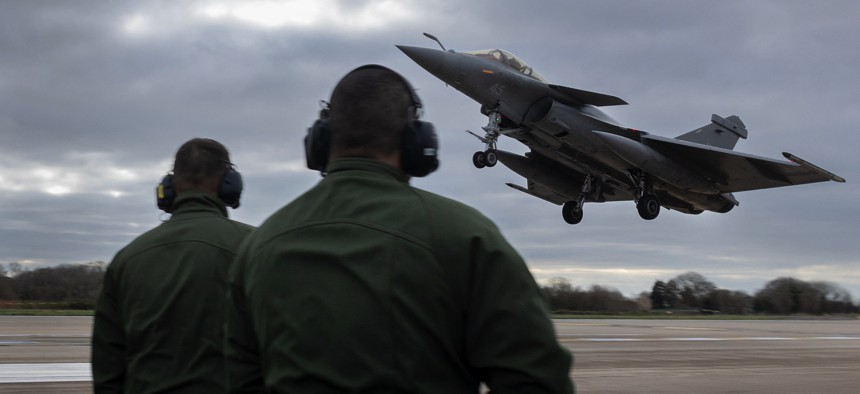
A Dassault Rafale F3R Marine executes a touch-and-go on January 12, 2024 at the French Navy's Lann-Bihoue airbase in Queven, France. FRED TANNEAU/AFP via Getty Images
What we learn from Serbia's intriguing fighter-jet choice
Belgrade's plan to buy its first Western-designed combat aircraft reveals trends in its military, the region, and Russia.
Serbian President Aleksandar Vucic has declared his country’s intention to acquire the Rafale jet fighter from France’s Dassault Aviation. The announcement – made while Vucic was on a two-day visit to France – noted that a firm contract signing is expected in two months.
The declaration of a French fighter purchase underlines Serbia’s intention to diversify its sources of military importation, while underlining the falloff of Russian defense exports in the wake of its invasion of Ukraine.
Serbia inherited much of its military inventory from the former Yugoslav Republic, which during the Cold War involved locally manufactured hardware supplemented extensively by high-end systems supplied from the former Soviet Union. With the demise of the latter coupled by the breakup for the former Yugoslavia, Serbia was left with older systems requiring extensive Russian support in the form of spare parts and upgrades, plus the occasional donation of surplus combat aircraft such as six MiG-29s transferred from Russia in October 2017.
With Serbia traditionally aligning more closely with Moscow and maintaining a level of detachment from NATO (for obvious reasons: see the 1999 Kosovo War) the overall military inventory of the Serbian armed forces remained heavily tilted towards Russian-designed systems.
But within the past decade signs began to appear that Serbia was interested in acquiring non-Russian systems as it slowly began upgrading its eroding military capabilities.
A first step in the effort to diversify its military aviation systems occurred on December 28, 2016, when Serbia agreed to procure nine H145M twin-engine multirole helicopters from Airbus (four of these were allocated to the Ministry of Interior).
This was followed by acquisition of unmanned aerial vehicles (UAVs) from China’s state-owned China Aerospace Science and Technology Corporation (CASC) Rainbow family of drones. These involved CH-92A armed reconnaissance drones and CH-95 long-range strike UAVs acquired from 2020 onwards.
Then, in February 2022, Serbia inked a €81 million government-to-government agreement with Spain for a pair of Airbus C-295 military transport aircraft.
Now, with Russia’s defense industry focused foremost on supporting the country’s stalemated invasion of Ukraine and the Moscow subject to trade and financial sanctions and Western export controls, Russian systems no longer present a palatable alternative for Serbia through the short-term.
A Rafale purchase will bring the first Western-designed fighter capability into the Serbian Air Force’s fleet, which currently consists of Yugoslav J-22 ground attack aircraft and Russian-made MiG-29s.
Perhaps equally interesting, Serbia opted for a combat aircraft acquired by neighboring Croatia, with whom Belgrade has long had an uneasy relationship.
At a different level, Serbia’s announcement of a Rafale procurement adds to the growing success of sales of that particular fighter in the immediate region. There were the second-hand Rafales were purchased by Croatia in November 2021, as well as 24 units purchased by Greece in two batches (18 of mixed new-build and used models in January 2021, plus six new additional units in March 2022).
On the flip side, Russia is seeing one of its traditional military export markets begin to slowly slip from its grasp.
The concentration of industry effort to supplying Russian forces in Ukraine erodes export potential by consuming most new production hardware and drawing away from after-sales support to foreign markets, particularly as spare parts are shifted to the Ukrainian front rather than to existing clients.
The threat of the U.S. CAATSA (Countering America’s Adversaries Through Sanctions Act) sanctions regime resulting in being barred from purchasing American-sourced military hardware also looms over some of Russia’s traditional buyers. While Serbia is disinclined to be concerned over CAATSA sanctions, others – such as Indonesia – have backed away from previous commitments on Russian systems purchases and instead opted for alternatives (in Indonesia’s case it too decided upon the Rafale to meet a vacated Su-35 purchase requirement).
Hence the Serbian decision to opt for the Rafale indicates two things: 1) A Serbian preference to diversify its hardware systems away from single-source dependence, and 2) Russia’s global arms sale market share continues to ebb since Moscow launched its invasion of Ukraine in February 2022.
NEXT STORY: What about Ukraine’s Abrams tanks?


